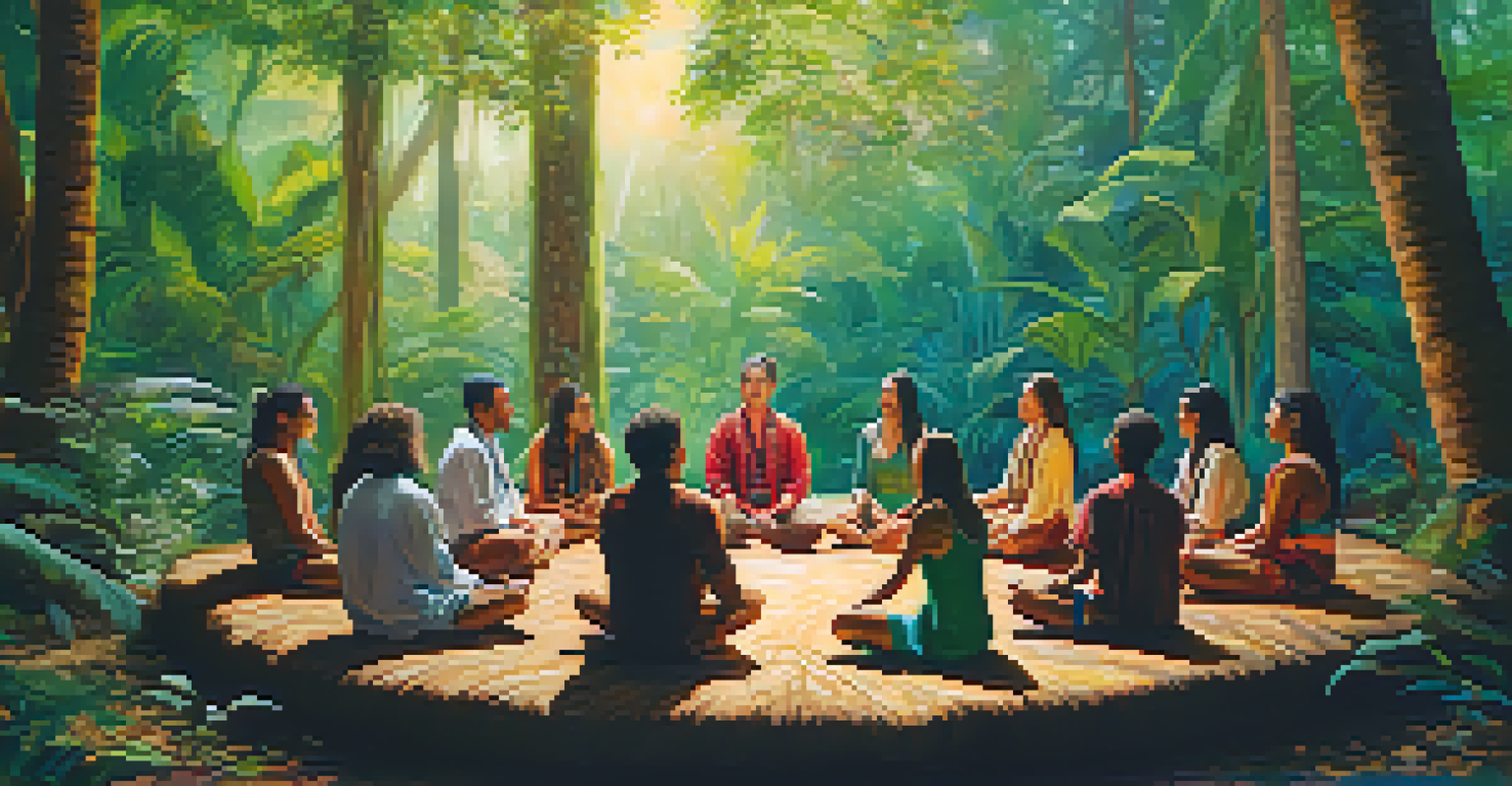Spiritual Journeys: Understanding the Ayahuasca Experience

What is Ayahuasca? Understanding the Basics
Ayahuasca is a traditional Amazonian brew made from the Banisteriopsis caapi vine and the Psychotria viridis leaf. This potent concoction has been used for centuries by indigenous tribes for spiritual and healing purposes. The brew contains the psychedelic compound DMT, which is believed to facilitate deep introspection and connection with a higher consciousness.
The experience of Ayahuasca is often described as a journey that reveals the depths of our consciousness.
The experience of consuming Ayahuasca is often referred to as a 'journey' due to its profound emotional and psychological effects. Participants typically engage in a guided ceremony led by a shaman, who helps navigate the experience. This context is crucial, as the setting and guidance can greatly influence the outcome of the journey.
While Ayahuasca is gaining popularity worldwide, it’s essential to approach it with respect and caution. Understanding the cultural significance and the potential risks involved is crucial for anyone considering this spiritual path.
The Setting: Importance of the Ceremony Space
The setting in which Ayahuasca is consumed plays a pivotal role in shaping the experience. Traditional ceremonies often take place in nature, surrounded by the sounds and sights of the Amazon rainforest. This immersive environment can enhance feelings of connection and grounding during the journey.

In contrast, modern retreats may offer a more controlled environment, which can sometimes feel less authentic. However, even in these settings, the intention behind the ceremony and the expertise of the facilitators can create a sacred atmosphere. It's vital for participants to feel safe and supported throughout the process.
Ayahuasca: A Healing Brew
Ayahuasca is a traditional Amazonian brew known for its potential to facilitate deep emotional healing and spiritual insight.
Ultimately, the optimal setting fosters trust and openness, allowing participants to explore their inner landscapes. A conducive environment can help individuals surrender to the experience, which is essential for meaningful insights and healing.
What to Expect During an Ayahuasca Journey
Each Ayahuasca journey is unique, but many participants report a range of sensations, emotions, and visions. The experience often begins with physical effects, such as nausea or purging, which are seen as a cleansing process. This can be unsettling but is often regarded as an essential part of the journey, allowing for emotional release.
Ayahuasca has the potential to heal, but it requires a commitment to understanding and integrating the lessons learned.
As the brew takes effect, participants may encounter vivid imagery and profound insights. Some might experience a sense of unity with the universe, while others may confront personal traumas or fears. These moments can be both challenging and enlightening, leading to significant personal growth.
Participants often describe a feeling of being guided or accompanied during their journey. This can be attributed to the shaman's presence, the energy of the group, or even the spirit of the plant itself. Such guidance can help individuals navigate through difficult emotions and emerge with clarity and a renewed sense of purpose.
The Healing Potential of Ayahuasca
Many individuals seek out Ayahuasca for its reputed healing properties, both physically and emotionally. Research has suggested that Ayahuasca may help alleviate symptoms of depression, anxiety, and PTSD. The brew's ability to bring unconscious thoughts to the surface can facilitate therapeutic breakthroughs.
Moreover, the communal aspect of Ayahuasca ceremonies fosters a sense of belonging and support among participants. Sharing experiences with others can be incredibly therapeutic, as it creates a safe space for vulnerability and connection. This collective healing aspect can enhance the overall experience.
Importance of Ceremony Setting
The setting of an Ayahuasca ceremony significantly influences the experience, emphasizing the need for a safe and supportive environment.
However, it’s essential to approach Ayahuasca as a complementary treatment rather than a cure-all. It’s advisable to combine the experience with professional therapy and ongoing support to fully integrate the insights gained during the journey.
Integrating Your Ayahuasca Experience
Integration refers to the process of making sense of and applying insights gained from the Ayahuasca journey. This can be one of the most challenging aspects, as participants may feel overwhelmed by new revelations. Taking time to reflect on the experience through journaling or discussions with trusted individuals can be incredibly helpful.
Many retreat centers offer integration support, including follow-up sessions and community gatherings. Engaging with others who have had similar experiences can foster understanding and connection. It’s important to remember that the journey doesn’t end when the ceremony is over; true transformation often takes time and effort.
Creating a personal integration plan can also be beneficial. This might include setting intentions, practicing mindfulness, or even seeking professional guidance. By actively working to integrate these insights into daily life, participants can cultivate lasting change and growth.
Risks and Considerations of Ayahuasca Use
While many individuals have positive experiences with Ayahuasca, it’s crucial to recognize the potential risks involved. Some people may experience psychological distress or negative reactions to the brew. It's particularly important for individuals with a history of mental health issues to consult with a healthcare professional before participating.
Additionally, the physical effects of Ayahuasca can be intense. Nausea, vomiting, and diarrhea are common and are seen as part of the purging process. However, these reactions can be distressing, especially for first-timers. Understanding and preparing for these possibilities can help mitigate anxiety during the ceremony.
Integrating Insights Post-Journey
Integration involves applying the insights gained from an Ayahuasca journey into daily life, which can be facilitated through reflection and community support.
Lastly, the legality and ethical implications of Ayahuasca use should not be overlooked. In some countries, Ayahuasca is illegal, while in others, it is protected as a sacred tradition. It’s essential to respect local laws and the cultural significance behind the practice.
The Future of Ayahuasca in Western Culture
As interest in Ayahuasca continues to grow in Western cultures, it raises important questions about appropriation and respect for indigenous practices. While many seek the profound healing and spiritual insights offered by the brew, it’s critical to approach these traditions with humility and understanding. Engaging with indigenous communities and supporting their rights is essential in preserving the integrity of Ayahuasca practices.
Moreover, scientific research into the effects of Ayahuasca is expanding, providing valuable insights into its potential therapeutic benefits. As more studies emerge, a greater understanding of the brew's impact on mental health and spirituality may pave the way for its acceptance in mainstream wellness practices.

Ultimately, the future of Ayahuasca in Western culture will depend on how we navigate these complex issues. By fostering respectful dialogue and collaboration with indigenous peoples, we can honor the traditions while exploring the profound possibilities that Ayahuasca offers.